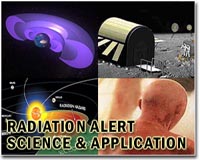 |
Osaka, Japan (AFP) March 20, 2011 Six workers at a quake-stricken nuclear power plant have been exposed to high levels of radiation but are continuing working there, its operator said Sunday. They have been exposed to more than 100 millisieverts of radiation, an official at the Tokyo Electric Power Co. said, adding he had no information on what tasks they were assigned to. "There has been no adverse effect on their health," Takeo Iwamoto said. It was not immediately known if they had been reassigned to different tasks. The government set 100 millisieverts as a limit for work in an emergency operation at a nuclear power plant in Japan. But the threshold has been raised to 250 for the on-going crisis at the Fukushima No. 1 plant. The limit for work in a normal situation at a nuclear power plant is 50 millisieverts. A 9.0-magnitude quake on March 11, followed by aftershocks and colossal tsunami waves, damaged the cooling systems of the plant, some 250 kilometres (155 miles) northeast of Tokyo, leaving it on the brink of a meltdown.
earlier related report Japan's health ministry had confirmed that the substance found in higher-than-usual doses in foods near the quake-damaged Fukushima No.1 plant northeast of Tokyo was radioactive iodine, the International Atomic Energy Agency said in a statement. "Though radioactive iodine has a short half-life of about eight days and decays naturally within a matter of weeks, there is a short-term risk to human health if radioactive iodine in food is absorbed into the human body," the Vienna-based body warned. "If ingested, it can accumulate in and cause damage to the thyroid." "Children and young people are particularly at risk of thyroid damage due to the ingestion of radioactive iodine," it added. Taking stable iodine -- as opposed to radioactive iodine -- tablets could however help prevent the harmful substance from accumulating in the thyroid, the watchdog said, noting that Japanese authorities had recommended evacuees from the plant's vicinity to take these precautions and that tablets and syrups had been distributed in evacuation centres around Japan. No other radioactive isotopes had been found in food products in unusual doses, it added. Japan announced earlier Saturday that it had detected abnormal levels of radiation in milk and spinach near the nuclear plant, which was critically damaged after last week's earthquake and tsunami, sending radioactive substances into the air. Traces of radioactive substances were also detected in Japan's tap water. However, the government reassured that both the food and the water did not present "an immediate health threat." The food contamination was measured between March 16 and 18, said the IAEA, which has been monitoring developments at the nuclear plant for the past week. IAEA director general Yukiya Amano also flew to Japan on Thursday to talk to nuclear and government officials there.
earlier related report "There is no scenario that foresees a worsening of the situation on the territory of Russia," he said during a visit to the island of Sakhalin, which lies close to Japan, according to Russian news agencies. There is anxiety in the Russian Far East about the possible arrival of nuclear contamination from Fukushima. Vladimir Asmolov, deputy director of the Russian nuclear energy company Rosenergoatom, backed up Putin's remarks. "There is no radioactive risk, everything else is speculation," he said. Local authorities in the Russian Far East say that since Sunday they have increased measurements of radioactivity and that so far levels are within normal limits. But the 175,000 inhabitants of Sakhalin and those living in the Primorie region, the capital of which is Vladivostok, have shown signs of anxiety, buying dosimeters and iodine capsules to swallow in case of contamination. Putin, president from 2000 to 2008, makes a habit of visits or spectacular actions in crisis situations, helping his popularity and strongman image.
Share This Article With Planet Earth
Related Links Space Technology News - Applications and Research
 Nuclear fears compound misery of Japan survivors
Nuclear fears compound misery of Japan survivorsMiyako, Japan (AFP) March 19, 2011 The nuclear crisis in Japan has struck fear and disbelief into quake and tsunami survivors who can barely take in the idea that a third life-threatening disaster might come their way. Frantic efforts to prevent a dangerous radiation leak at the crippled Fukushima nuclear plant on the eastern coast have dominated global concerns in the wake of the massive earthquake and ensuing tsunami last w ... read more |
|
| The content herein, unless otherwise known to be public domain, are Copyright 1995-2010 - SpaceDaily. AFP and UPI Wire Stories are copyright Agence France-Presse and United Press International. ESA Portal Reports are copyright European Space Agency. All NASA sourced material is public domain. Additional copyrights may apply in whole or part to other bona fide parties. Advertising does not imply endorsement,agreement or approval of any opinions, statements or information provided by SpaceDaily on any Web page published or hosted by SpaceDaily. Privacy Statement |